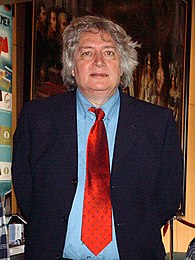Jan Timman
| Jan Timman | |
|---|---|
 Timman in 1984 | |
| Full name | Jan Hendrik Timman |
| Country | Netherlands |
| Born | 14 December 1951 Amsterdam, Netherlands |
| Title | Grandmaster (1974) |
| FIDE rating | 2527 (June 2024) |
| Peak rating | 2680 (January 1990) |
| Peak ranking | No. 2 (January 1982) |
Jan Timman (born 14 December 1951) is a Dutch
Early career
He is the son of mathematics professor Rein Timman and his wife Anneke, who as a schoolgirl was a mathematics student of former world champion Max Euwe.[3] His older brother, Ton (1946–2014), held the chess title of FIDE Master. Jan Timman was already an outstanding prospect in his early teens, and at Jerusalem 1967 played in the World Junior Championship, aged fifteen, finishing third.
Timman received the
1979.Tournament successes
By 1982 Timman was ranked second in the world, behind only
World Championship Candidate
Timman's world championship career began at the zonal tournaments at
Olympiad career

Timman represented the Netherlands in 13
Later career
Timman continues to play actively. In 2004 he placed equal first in a tournament in Reykjavík and was equal second at Amsterdam. He played in the gold medal-winning Dutch team at the European Team Chess Championships in Gothenburg in 2005, alongside Loek van Wely, Ivan Sokolov, Sergei Tiviakov, and Erik van den Doel. In 2006 he won the Sigeman Tournament in Malmö Sweden and was second in the Howard Staunton Memorial in London.
Writings
Timman is one of the chief editors of the magazine
Style
Timman likes to challenge opponents directly in the areas of their strengths. Yasser Seirawan describes a game where Timman had an over-the-board inspiration to opt for a complicated game—the kind that Timman knew Seirawan really enjoyed—in spite of having prepared an equalizing variation beforehand. Timman's fearlessness has caused him to lose a lot of games, but also makes him a feared competitor because nobody likes to lose from their favourite positions.[9] Raymond Keene described Timman's playing style as that of "a fighter, in the mould of Emanuel Lasker".[5]
He has always adopted a wide and varied opening repertoire, playing an array of different systems as both White and Black. When he first reached the world class level in the 1970s, this was relatively unusual, with most elite grandmasters deploying a more narrowly focused range of openings, but it is now the norm.[10]
Example game
| a | b | c | d | e | f | g | h | ||
| 8 |  | 8 | |||||||
| 7 | 7 | ||||||||
| 6 | 6 | ||||||||
| 5 | 5 | ||||||||
| 4 | 4 | ||||||||
| 3 | 3 | ||||||||
| 2 | 2 | ||||||||
| 1 | 1 | ||||||||
| a | b | c | d | e | f | g | h | ||
This game, played between Timman and Garry Kasparov in Hilversum on 17 December 1985, is a good example of Timman's style:
- Timman vs. Garry Kasparov, Hilversum 1985; Ruy Lopez, Zaitsev Variation
1.e4 e5 2.Nf3 Nc6 3.Bb5 a6 4.Ba4 Nf6 5.0-0 Be7 6.Re1 b5 7.Bb3 d6 8.c3 0-0 9.h3 Bb7 10.d4 Re8 11.Ng5 Rf8 12.Nf3 Re8 13.Nbd2 Bf8 14.a3 h6 15.Bc2 Nb8 16.b4 Nbd7 17.Bb2 g6 18.c4 exd4 19.cxb5 axb5 20.Nxd4 c6 21.a4 bxa4 22.Bxa4 Qb6 23.Nc2 Qc7 24.Bb3 Ba6 25.Rc1 Bg7 26.Ne3 Bb5 27.Nd5 Nxd5 28.Bxg7 Kxg7 29.exd5 Ne5 30.Ne4 Nd3 31.Qd2 Ra3 32.Nf6 Rxe1+ 33.Rxe1 Kxf6 34.Qc3+ Ne5 35.f4 Ba4 36.fxe5 dxe5 (see diagram; at this point, Timman finds a game-ending combination) 37.d6 Qxd6 38.Qf3+ Ke7 39.Qxf7+ Kd8 40.Rd1 Ra1 41.Qf6+ (Kasparov cannot hang on to his queen) 1–0[11]
Personal life
Timman married twice, with a son and a daughter from the first marriage.[citation needed]
References
- ^ "Timman stages comeback". Washington Times. 2005-05-06. Retrieved 20 June 2010.
- ^ "Chess News - The Amsterdam Chess Tournament revisited". ChessBase. 2005-07-30. Retrieved 20 June 2010.
- ISBN 9789056914844. Retrieved 16 April 2018 – via Google Books.
- )
- ^ ISBN 978-0-14-046452-8.
- ^ Mark Weeks' men's world championship pages
- ^ Bartelski, Wojciech. "Men's Chess Olympiads: Jan Timman". OlimpBase. Archived from the original on 24 September 2015. Retrieved 21 October 2010.
- ^ "ECF Book of the Year 2017". 29 September 2017.
- ISBN 978-1857443479.
- ISBN 1-901983-89-7.
- ^ "Timman vs. Kasparov, 1985". Chessgames.com.
External links
- Jan Timman player profile and games at Chessgames.com
